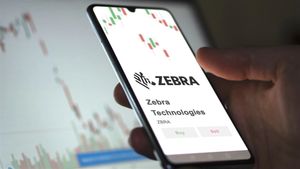Financial News
The Unsettling Dance: Robust Growth and Stubborn Inflation Challenge the Fed's Resolve

The U.S. economy currently navigates an intriguing, yet precarious, path as hypothetical Q2 2025 data suggests a robust rebound in Gross Domestic Product (GDP) growth. This economic buoyancy, however, is shadowed by the persistent specter of inflation, with the Personal Consumption Expenditures (PCE) price index stubbornly holding above the Federal Reserve's 2.0% target. This confluence of strong growth and elevated prices presents a significant paradox, sending conflicting signals to policymakers and financial markets, forcing a re-evaluation of economic stability and future monetary policy.
This perplexing scenario defies conventional economic wisdom, where strong growth might typically lead to a more manageable inflation picture, or aggressive inflation-fighting measures would temper growth. Instead, the current environment points to an economy running hot on both fronts, creating a challenging "new normal" for businesses, investors, and the Federal Reserve, which is grappling with how to fulfill its dual mandate in an increasingly complex global economic landscape.
The Paradox Unfolds: What Happened and Why It Matters
Hypothetical Q2 2025 figures indicate a significant economic expansion, with real GDP increasing at an impressive annualized rate, potentially around 3.3%. This marks a strong turnaround from earlier periods and is largely driven by resilient consumer spending and healthy business investment, suggesting underlying economic strength and consumer confidence. However, this positive growth narrative is simultaneously tempered by persistent inflationary pressures. The PCE price index, the Federal Reserve’s preferred inflation gauge, hypothetically rose by 2.6% year-on-year in June 2025, with core PCE (excluding volatile food and energy components) at 2.8%. While the headline Q2 PCE might have touched 2.0%, other indicators and projections for later in 2025 still point to sustained price increases, influenced by factors like accelerating services-sector prices and, notably, a surge in average effective tariff rates to 18.6% in 2025.
This dynamic implies that strong demand is outpacing the economy's productive capacity, causing rising raw material and labor expenses to be passed on to consumers. Increased consumer spending and wages further contribute to this cycle, making inflation difficult to control. The simultaneous occurrence of robust GDP growth and persistent inflation sends contradictory signals about the economy's health. Robust growth typically indicates a thriving economy, often leading to optimism, while high inflation points to an overheating economy, demanding a restrictive policy response. This ambiguity creates significant uncertainty about the true state of the economy and the appropriate policy path forward.
The Federal Reserve operates under a "dual mandate" to achieve both maximum employment and price stability (defined as a 2% PCE inflation target). This hypothetical scenario creates a profound challenge to this mandate. With robust GDP growth potentially satisfying the employment side of the mandate, persistent inflation directly conflicts with the price stability goal. The Fed faces a "precarious balancing act": aggressive monetary tightening to combat inflation risks stifling economic growth and potentially increasing unemployment, while prioritizing growth risks embedding higher inflation expectations. Hypothesized minutes from a July 2025 FOMC meeting revealed internal divisions on the path forward, with some officials arguing for rate cuts to address employment risks despite concerns over tariff-driven inflation, highlighting the difficulty in finding a consensus policy.
Initial reactions from financial markets are characterized by heightened volatility and cautious optimism. While strong GDP growth initially led to a rally in equity markets and eased recession concerns, the persistent inflation quickly dampened enthusiasm. Investors are balancing optimism from economic expansion against the specter of monetary policy tightening, with higher inflation expectations pushing interest rates higher—a "formidable headwind" for growth stocks. Economists are largely "perplexed" by the enduring inflation despite efforts to curb it, with many anticipating it to persist above the 2% target beyond 2026. This "inflation paradox" demands careful navigation, focusing on how the Fed will manage the "delicate dance" between growth and price stability.
Winners and Losers in an Inflationary Growth Landscape
In an economy marked by both strong GDP growth and persistent inflation, not all sectors or companies fare equally. Those with inherent advantages, particularly in pricing power and essential services, are poised to thrive, while others struggle with rising costs and diminished consumer purchasing power.
Companies possessing strong pricing power are clear winners. These firms can raise prices without significantly losing market share, allowing them to offset rising input costs and maintain or expand profit margins. This ability often stems from strong brands, product differentiation, or essential services. Examples include consumer staples giants like Procter & Gamble (NYSE: PG) and PepsiCo (NASDAQ: PEP), whose everyday products remain in demand regardless of inflation, and luxury goods conglomerates such as LVMH Moët Hennessy Louis Vuitton (OTCMKTS: LVMUY), catering to less price-sensitive high-income consumers. Select software and technology companies with proprietary technology or essential licenses, like Microsoft (NASDAQ: MSFT) and Broadcom (NASDAQ: AVGO), can also command higher prices due to the critical nature of their offerings and limited competition.
The financial sector, particularly large commercial banks like JPMorgan Chase (NYSE: JPM) and Bank of America (NYSE: BAC), typically benefits from rising interest rates, which are a common response to persistent inflation. Banks can increase the interest rates they charge on loans more quickly than the rates they pay on deposits, leading to wider net interest margins. Strong GDP growth also generally translates to increased lending activity and lower default rates. Similarly, the energy sector, represented by integrated oil and gas companies like ExxonMobil (NYSE: XOM) and Chevron (NYSE: CVX), often performs well as strong economic growth drives demand for energy, pushing up prices for oil and natural gas. Healthcare providers, such as Eli Lilly and Company (NYSE: LLY) and HCA Healthcare (NYSE: HCA), also tend to be resilient due to the inelastic demand for their essential services. Certain industrials, particularly defense contractors like Lockheed Martin (NYSE: LMT) and BAE Systems (OTCMKTS: BAESY), benefit from long-term government contracts and essential services, making their demand less sensitive to economic fluctuations.
Conversely, companies with limited pricing power are likely to be losers. Businesses in highly competitive markets or those offering undifferentiated products struggle to pass on increased costs, leading to margin erosion. Examples include commodity manufacturers (e.g., basic chemicals) and many players in the restaurants and hospitality industries, which are highly sensitive to rising food, labor, and energy costs. Discretionary consumer spending sectors also face headwinds as inflation erodes purchasing power, causing consumers to cut back on non-essential goods. Retailers of durable goods like Best Buy (NYSE: BBY) and Home Depot (NYSE: HD), as well as the automotive industry with General Motors (NYSE: GM) and Ford (NYSE: F), could see reduced sales as higher prices and rising interest rates deter purchases.
Finally, growth stocks and highly leveraged companies are vulnerable. Growth stocks, whose valuations depend heavily on discounted future cash flows, see their present value diminish as higher interest rates increase the discount rate. Highly leveraged companies, regardless of sector, face increased borrowing costs, squeezing profitability. Early-stage technology companies or those with significant variable-rate debt are particularly exposed, as the cost of financing expansion becomes prohibitively expensive. Real estate developers and homebuilders like D.R. Horton (NYSE: DHI) and Lennar (NYSE: LEN) also face challenges from rising mortgage rates, which reduce housing affordability and demand.
Broader Implications: Navigating a Shifting Economic Landscape
The coexistence of strong economic growth and persistent inflation beyond the Fed's target in hypothetical Q2 2025 creates a profound and wide-ranging impact, fitting into broader industry trends and signaling a potential "new normal" for economic management. This scenario suggests that robust demand might be outpacing the economy's supply capacity, leading to continued upward pressure on prices, even amidst expansion.
One significant trend influencing this paradox is the impact of tariffs. Elevated trade barriers, with the average effective tariff rate surging to 18.6% in 2025, are acting as a significant inflationary driver. These tariffs disproportionately affect consumer goods, leading to higher prices for items like shoes and apparel. While tariffs have provided a boost to domestic manufacturing growth, they have simultaneously increased input costs for sectors like construction and agriculture, creating a complex web of economic winners and losers. This highlights how geopolitical strategies can directly complicate monetary policy by injecting supply-side inflation.
The persistent inflationary pressures are also driving a fundamental shift in supply chain management. Businesses are moving away from "just-in-time" models towards "just-in-case" strategies, prioritizing resilience over pure efficiency. This involves diversifying manufacturing locations, implementing "China plus one" strategies, and nearshoring to mitigate disruptions and rising costs. These adaptations, while potentially increasing short-term costs, are deemed essential for long-term operational stability. The ripple effects extend to competitors and partners, with companies facing increased costs for raw materials, energy, labor, and transportation. Those unable to efficiently pass these costs to consumers risk reduced profitability, while others are renegotiating supplier contracts and enhancing supply chain agility.
From a regulatory and policy standpoint, the Federal Reserve faces an exacerbated dilemma. Strong economic growth typically suggests less need for monetary stimulus, but persistent inflation calls for tighter policy. The Fed has indicated a willingness to keep interest rates "higher for longer" if inflation remains elevated, despite market speculation about potential rate cuts. Tariffs further complicate the Fed's inflation outlook, as they directly contribute to price pressures, potentially delaying rate cuts. Fiscal policy also plays a crucial role; while thoughtful deficit reduction could temper demand and complement monetary policy, expansionary fiscal measures, particularly those contributing to tariffs, have been identified as factors fueling the current inflationary environment.
Historically, this scenario invites comparisons to stagflation of the 1970s. However, the current environment differs significantly: while inflation is persistent, the robust GDP growth observed in Q2 2025 indicates the economy is not stagnant, thus avoiding classical stagflation. Instead, this situation points towards a "new normal" for monetary policy. The previous "new normal" was characterized by low growth and low inflation. The current environment, with persistent inflation despite strong growth, suggests an era where supply constraints, geopolitical tensions, and tariff policies play a more prominent role. This implies that future monetary policy may need to be more vigilant and adaptable to supply-side shocks, operating in an environment where inflation is "more persistent than originally expected," demanding an evolution in the Fed's tools and strategies to achieve price stability.
What Comes Next: Navigating the Tense Tightrope
The path forward for the economy, the Federal Reserve, and investors in this perplexing environment of robust growth and persistent inflation is fraught with both opportunities and considerable challenges. The immediate future will likely see the U.S. economy continue its unexpected resilience, potentially extending strong GDP growth into late 2025, but the shadow of stubborn inflation, with core PCE and CPI above target, will remain a primary concern. In the long term, sustained high inflation, particularly if driven by a wage-price spiral, risks eroding profit margins and reducing real wages, despite nominal economic expansion. Long-term interest rates are projected to remain elevated, a significant departure from the ultra-low rates of previous decades, ushering in a "higher for longer" rate environment that could dampen future growth and investment.
The Federal Reserve is on a "tense tightrope," with its policy trajectory heavily influenced by the inflation outlook. While some policymakers may favor rate cuts due to moderating economic activity in certain areas, lingering tariff uncertainty and persistent inflationary pressure remain significant barriers. The Fed's primary objective remains price stability, and if inflation continues to accelerate or show persistence, the central bank is likely to maintain current interest rates or even consider further hikes. The impact of new tariffs, contributing to upward pressure on inflation, further complicates the Fed's calculus, potentially delaying any significant easing. The uncertainty demands that the Fed emphasizes the critical importance of keeping longer-term inflation expectations well-anchored to prevent an ongoing inflation problem.
For investors, adapting their strategies is paramount. This environment necessitates a potential shift from traditional portfolios. Reducing exposure to low-yield, long-duration bonds, which are vulnerable to inflation erosion, and increasing allocations to equities with strong pricing power is advisable. Inflation-hedged assets such as Treasury Inflation-Protected Securities (TIPS), commodities (e.g., gold, oil), and real assets like real estate (including REITs) offer protection. Focus should be on companies that can pass increased costs to consumers without impacting demand, such as those in consumer staples, utilities, and healthcare. Diversification across various inflation-hedging assets and a focus on companies with strong current cash flows are crucial to navigate potential market volatility.
Businesses must implement proactive strategic pivots. Dynamic pricing and rigorous cost management are essential to safeguard profit margins. Flexible financial planning and analysis (FP&PA) processes, including "what-if" scenario simulations, will enable rapid adaptation. Strengthening supply chain resilience through diversification, nearshoring, and securing long-term vendor agreements is critical to mitigate cost volatility. Optimizing product portfolios, investing in automation to reduce labor costs, and prudent debt management will also be key. Market opportunities exist in resilient sectors like consumer discretionary (which saw strong Q2 performance) and healthcare, alongside demand for inflation hedges. However, challenges include eroded purchasing power, higher borrowing costs, margin compression for companies without pricing power, and ongoing policy uncertainty.
Several scenarios could unfold from this unique combination of strong GDP and persistent inflation. The 'No Landing' scenario is gaining traction, where robust economic growth continues despite the Fed's efforts to cool inflation, meaning inflation remains stubbornly elevated alongside strong economic activity. This would likely entail a prolonged period of restrictive monetary policy. A Prolonged Inflation (Mild Stagflation) scenario could emerge if inflation becomes entrenched, weighing on growth for an extended period, though without the severe stagnation of the 1970s. While a Soft Landing (moderate growth slowdown with controlled inflation) remains the Fed's goal, the current data makes it a challenging outcome. A Hard Landing (aggressive policy causing a recession) remains a risk if the Fed feels compelled to raise rates too high or too quickly. The "no landing" scenario, however, appears a significant possibility, suggesting a prolonged period of both robust growth and elevated inflation, underscoring the need for continued vigilance and adaptability.
Conclusion: A New Era of Economic Vigilance
The hypothetical Q2 2025 economic data, showcasing a robust rebound in GDP growth alongside persistently high PCE inflation, marks a pivotal moment, signaling a potential new era of economic dynamics. This "inflation paradox" underscores that the U.S. economy is operating at high capacity with enduring price pressures, creating a complex challenge for policymakers and a volatile landscape for financial markets. The Federal Reserve is caught in a delicate balancing act, compelled to maintain a vigilant and likely restrictive stance on monetary policy to tame inflation without inadvertently stifling growth.
Key takeaways from this intricate scenario include the critical role of tariffs in fueling inflation, the necessary pivot towards supply chain resilience, and the profound implications for the Fed's dual mandate. Businesses must prioritize agility, cost management, and the cultivation of pricing power to navigate rising input costs. Investors, meanwhile, need to recalibrate their portfolios, favoring inflation-hedging assets and companies with strong fundamentals over highly speculative growth plays. The potential for a "no landing" scenario, where both strong growth and elevated inflation persist, suggests that the market will continue to grapple with uncertainty, requiring sophisticated risk management and adaptive strategies.
Moving forward, all eyes will remain on the Federal Reserve's policy decisions, particularly regarding interest rate adjustments and its communication strategy. Investors should closely monitor incoming inflation data, especially core PCE, as well as labor market indicators and consumer spending trends. Geopolitical developments, particularly those impacting trade and supply chains, will also be crucial factors influencing both inflation and growth. This complex economic environment demands continuous vigilance, strategic foresight, and an acceptance that the established rules of engagement in financial markets may be undergoing a fundamental and lasting transformation.
More News
View More




Recent Quotes
View More
Quotes delayed at least 20 minutes.
By accessing this page, you agree to the Privacy Policy and Terms Of Service.



